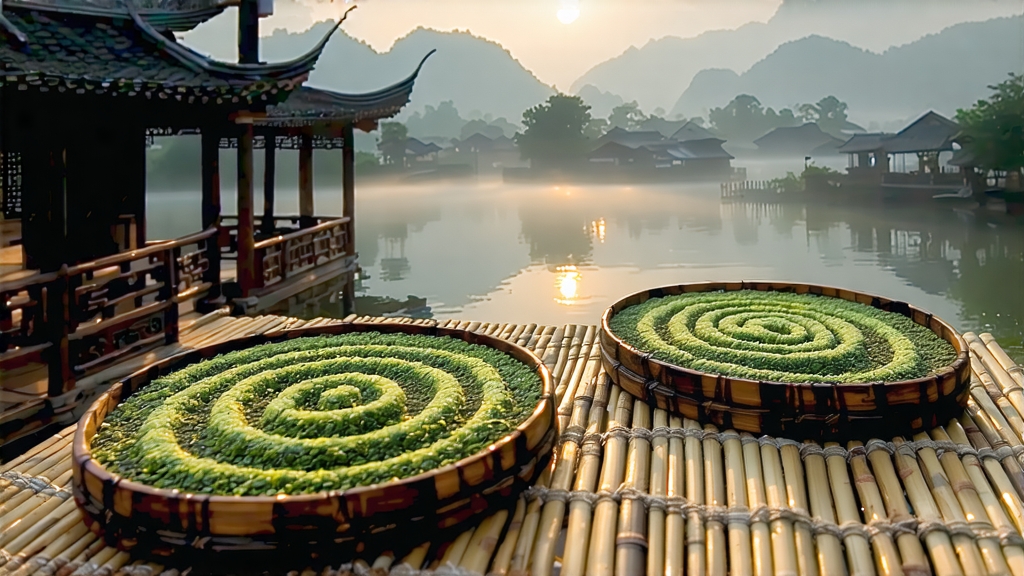
Tucked between the mist-laden hills of Dongting Mountain and the rippling waters of Lake Tai in Jiangsu Province, Biluochun—literally “Green Snail Spring”—has charmed Chinese emperors, poets, and now the world for more than three centuries. Its name alone evokes the image of tiny jade spirals that resemble the whorls of a snail shell, plucked in the first breath of spring when the hills are still veiled in silver fog. To international tea lovers accustomed to the flat blades of Longjing or the needle elegance of Huangshan Maofeng, Biluochun offers a different grammar of beauty: a curled bud that unfurls in hot water like a time-lapse peony, releasing an aroma so fragrant that local growers once called it “scary fragrance” (xia sha ren xiang) until the Kangxi Emperor rechristened it “Green Snail Spring” in 1699.
History and Legend
The story begins in the Ming dynasty, when tea bushes were planted between fruit trees—peach, plum, and apricot—on the terraced slopes of Dongting. Inter-cropping was not deliberate aesthetics but practical agronomy; the fruit blossoms lent their perfume to the tender leaves, while the tea roots stabilized the fragile mountain soil. By the late 1600s the tea had reached the imperial court in Beijing. Court chronicles record that the Kangxi Emperor, visiting Lake Tai incognito, was served a cup whose leaves leapt and danced in the glass. Enchanted, he asked the name, disliked the coarse original, and penned the elegant “Biluochun” on the spot. From that moment the tea became a tribute item, carried north each spring on fast horses along the Grand Canal.
Micro-Terroirs and Varietals
Today the appellation “Biluochun” is protected by Chinese geographical indication law, limited to the Dongting East and West Mountains in Wuzhong District, Suzhou. Within this tiny radius micro-terroirs flourish. The true pedigree is the “Xiao Ye” or small-leaf cultivar, a landrace that evolved on the granite soils, its leaves barely 2 cm long, ideal for the fine spiral. Around the lake shore, newer gardens plant the “Fuding Dabaicha” cultivar for higher yield; purists dismiss it as “Jiang Biluochun,” conceding only that it gives a softer, less mineral cup. Elevation matters: bushes above 200 m ripen ten days later, accumulating more aromatic precursors, while fog at 300 m acts as a natural shade cloth, boosting chlorophyll and theanine. The most coveted lot, “Mingqian Toucai,” is picked three days before the Qingming festival when each bud still wears its downy cloak and weighs barely 0.05 g.
Pluck Standard
Biluochun is the earliest green tea harvested in China. The rule is “one bud with one unfolding leaf,” the leaf no larger than the unopened bud itself. Experienced pickers pinch at the node so the tiny scar remains green and will not oxidize during frying. A full kilogram of finished tea demands 60,000 such tips, all plucked between 5 a.m. and 9 a.m. while the dew is still cool. After 10 a.m. the rising sun wilts the cells, reducing the signature pekoe aroma.
Crafting the Spiral
Unlike pan-fired teas that rely on a hot metal surface, Biluochun is shaped entirely in the hand. The fresh leaves are first spread 3 cm thick on bamboo trays for three hours of withering, losing about 10 % moisture and the grassy edge. Next comes “sha qing” or kill-green, but here the wok temperature is a gentle 120 °C, just enough to denature enzymes without roasting the down. The master’s left hand gathers the leaves into a loose bundle while the right hand rolls them against the wok with three fingers, pressing, shaking, and tossing in one fluid rhythm. After four minutes the leaves turn dark jade and begin to curl; temperature drops to 80 °C for the “cuo tuan” phase, where the bud is spiraled into its final snail shell. The entire process lasts 15 minutes, short enough to lock in 4 % chlorophyll yet long enough to reduce moisture to 30 %. A final low-temperature drying at 60 °C for 20 minutes sets the curl and raises the aroma compounds